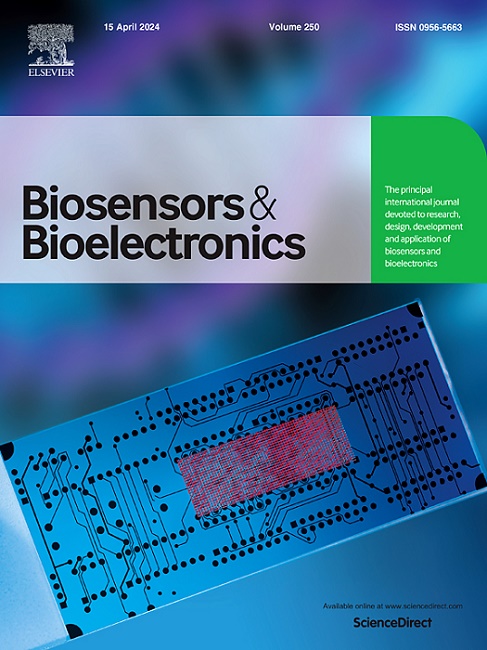纸侧流动试纸条比较可见光与近红外荧光检测血浆中microRNA
IF 10.5
1区 生物学
Q1 BIOPHYSICS
引用次数: 0
摘要
目前流行的比色纸横向流动试纸(PLFSs)价格低廉,易于未经培训的人员使用,但其灵敏度低,且容易受到血浆等复杂样品基质的严重干扰。因此,我们开发了一种基于近红外荧光(NIRF)的PLFS,可以直接检测血浆中的microRNA (miRNA),而无需进一步的样品预处理。为了减轻有机NIRF染料分子的低强度和光不稳定性问题,合成了染料封装的二氧化硅纳米颗粒,并将其纳入PLFS中用于miRNA检测。为了证明NIRF的优势,我们还构建了一个基于可见光荧光(VisF)的PLFS作为对照。实验结果表明,在缓冲溶液中测量miRNA时,荧光发射波长为773 nm的nif - plfs与荧光发射波长为542 nm的VisF-PLFS具有相当的传感性能。然而,在测量血浆样品中的miRNA时,nif - plfs在线性检测范围和检测限方面表现出远优于vis - plfs的性能。在稀释后的血浆样品中,nif - plfs对miRNA的检测限为50 pM,比vis - plfs低两个数量级。开发的nif - plfs作为检测人体液体样本中疾病生物标志物的即时护理(POC)工具具有巨大潜力。本文章由计算机程序翻译,如有差异,请以英文原文为准。
Comparative visible-light and near-infrared fluorescence detection of microRNA in blood plasma with paper lateral flow test strips
Prevailing colorimetric paper lateral flow strips (PLFSs) are inexpensive and easy to use by untrained personnel, but suffer from low sensitivity and severe interference from complex sample matrices such as blood plasma. Hence, a PLFS based on near-infrared fluorescence (NIRF) has been developed to directly detect microRNA (miRNA) in blood plasma without any further sample pretreatment. To mitigate the issue of low intensity and photo-instability of organic NIRF dye molecules, the dye-encapsulated silica nanoparticles have been synthesized and incorporated into a PLFS for miRNA detection. To demonstrate the advantage of NIRF, a PLFS based on visible-light fluorescence (VisF) has also been constructed as the control. The test results reveal that the NIRF-PLFS with fluorescence emission at 773 nm exhibits sensing performance comparable to the VisF-PLFS with fluorescence emission at 542 nm when measuring miRNA in buffer solution. However, the NIRF-PLFS shows far superior performance over the VisF-PLFS in terms of the linear detection range and the limit of detection when measuring miRNA in blood plasma samples. The NIRF-PLFS has achieved a limit of detection of 50 pM toward miRNA in the diluted blood plasma sample, two orders of magnitude lower than that of the VisF-PLFS. The developed NIRF-PLFS exhibits great potential as a point-of-care (POC) tool in detection of disease biomarkers in human fluid samples.
求助全文
通过发布文献求助,成功后即可免费获取论文全文。
去求助
来源期刊

Biosensors and Bioelectronics
工程技术-电化学
CiteScore
20.80
自引率
7.10%
发文量
1006
审稿时长
29 days
期刊介绍:
Biosensors & Bioelectronics, along with its open access companion journal Biosensors & Bioelectronics: X, is the leading international publication in the field of biosensors and bioelectronics. It covers research, design, development, and application of biosensors, which are analytical devices incorporating biological materials with physicochemical transducers. These devices, including sensors, DNA chips, electronic noses, and lab-on-a-chip, produce digital signals proportional to specific analytes. Examples include immunosensors and enzyme-based biosensors, applied in various fields such as medicine, environmental monitoring, and food industry. The journal also focuses on molecular and supramolecular structures for enhancing device performance.
 求助内容:
求助内容: 应助结果提醒方式:
应助结果提醒方式:


